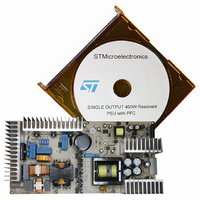EVAL6599-400W-S STMicroelectronics, EVAL6599-400W-S Datasheet - Page 23

EVAL6599-400W-S
Manufacturer Part Number
EVAL6599-400W-S
Description
DEMO BOARD FOR L6599
Manufacturer
STMicroelectronics
Type
Power Factor Correctionr
Specifications of EVAL6599-400W-S
Main Purpose
AC/DC, Primary Side and PFC
Outputs And Type
3, Isolated
Power - Output
400W
Voltage - Output
200V, 5V, 3.3V
Current - Output
2A, 1A, 700mA
Voltage - Input
90 ~ 264VAC
Regulator Topology
Resonant
Board Type
Fully Populated
Utilized Ic / Part
L6563, L6599
Input Voltage
90 V to 264 V
Output Voltage
3.3 V to 200 V
Dimensions
132 mm x 265 mm
Product
Power Management Modules
Lead Free Status / RoHS Status
Lead free / RoHS Compliant
For Use With/related Products
L6599
Other names
497-5856
Available stocks
Company
Part Number
Manufacturer
Quantity
Price
L6599
7.4
Current sense, OCP and OLP
The resonant half-bridge is essentially voltage-mode controlled; hence a current sense input
will only serve as an overcurrent protection (OCP).
Unlike PWM-controlled converters, where energy flow is controlled by the duty cycle of the
primary switch (or switches), in a resonant half-bridge the duty cycle is fixed and energy flow
is controlled by its switching frequency. This impacts on the way current limitation can be
realized. While in PWM-controlled converters energy flow can be limited simply by
terminating switch conduction beforehand when the sensed current exceeds a preset
threshold (this is commonly now as cycle-by-cycle limitation), in a resonant half-bridge the
switching frequency, that is, its oscillator's frequency must be increased and this cannot be
done as quickly as turning off a switch: it takes at least the next oscillator cycle to see the
frequency change. This implies that to have an effective increase, able to change the energy
flow significantly, the rate of change of the frequency must be slower than the frequency
itself. This, in turn, implies that cycle-by-cycle limitation is not feasible and that, therefore,
the information on the primary current fed to the current sensing input must be somehow
averaged. Of course, the averaging time must not be too long to prevent the primary current
from reaching too high values.
In
described in the following. The circuit of
resistor Rs might not be negligible, hurting efficiency; the circuit of
complex but virtually lossless and recommended when the efficiency target is very high.
Figure 30. Current sensing technique with sense resistor
Figure 30 and Figure 31
L6599
6
a couple of current sensing methods are illustrated that will be
ISEN
τ
≈
f
10
min
Figure 30
Rs
Cr
is simpler but the dissipation on the sense
I
Cr
Vspk
0
Application information
Figure 31
is more
L6599
23/36
6
















